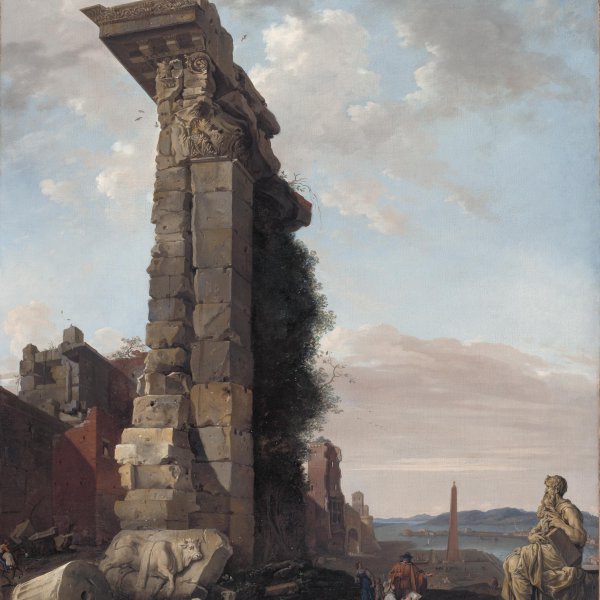Bartholomeus Breenbergh
Deventer, 1598-Amsterdam, 1657
A Dutch landscape painter and printmaker, Breenbergh was born in Deventer to a wealthy Protestant family. Nothing is known of his early years and initial training except that on the death of his father in 1607 the family moved to Hoorn. Breenbergh is next mentioned in a judicial document that locates him in Amsterdam in 1619 and refers to him for the first time as a painter.
Breenbergh belonged to the group of Italianate painters that travelled to Rome in their youth, where he is documented in late 1619. There he made contact with the painter Paul Bril with whom Breenbergh stated that he studied for seven years, copying large numbers of his works. Breenbergh was a founder member of the Schildersbent, the association of northern artists resident in Rome and received the nickname of Het Fret [The Ferret].
Numerous drawings of Roman landscapes date from this period. They depict classical ruins and buildings and are clearly influenced by the work of the painters Paul Bril and Cornelis Poelenburgh.
The precise date of Breenbergh’s return to Holland is not known, but he is documented in Amsterdam in 1633, the year that he married Rebecca Schellingwou.
Breenbergh was most active in the 1630s and his work reveals a series of innovations that would mark the start of his mature period. He began to introduce mythological and biblical figures into his landscapes and to favour Old Testament scenes, clearly influenced by Pieter Lastman and other artists of the generation prior to Rembrandt.
Breenbergh remained in Amsterdam until his death in 1657. During the last fifteen years of his life his output notably diminished and from 1652 he devoted his energies to commercial activities. His later works are far removed from his simple early Italian views and landscapes and are notable for their monumental compositions and expressive figures.
Breenbergh belonged to the group of Italianate painters that travelled to Rome in their youth, where he is documented in late 1619. There he made contact with the painter Paul Bril with whom Breenbergh stated that he studied for seven years, copying large numbers of his works. Breenbergh was a founder member of the Schildersbent, the association of northern artists resident in Rome and received the nickname of Het Fret [The Ferret].
Numerous drawings of Roman landscapes date from this period. They depict classical ruins and buildings and are clearly influenced by the work of the painters Paul Bril and Cornelis Poelenburgh.
The precise date of Breenbergh’s return to Holland is not known, but he is documented in Amsterdam in 1633, the year that he married Rebecca Schellingwou.
Breenbergh was most active in the 1630s and his work reveals a series of innovations that would mark the start of his mature period. He began to introduce mythological and biblical figures into his landscapes and to favour Old Testament scenes, clearly influenced by Pieter Lastman and other artists of the generation prior to Rembrandt.
Breenbergh remained in Amsterdam until his death in 1657. During the last fifteen years of his life his output notably diminished and from 1652 he devoted his energies to commercial activities. His later works are far removed from his simple early Italian views and landscapes and are notable for their monumental compositions and expressive figures.





